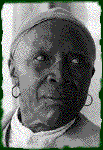
Chapter II.
REMEMBERING SLAVERY
THE TAPES/BROADCASTS
The tapes/broadcasts portion of Remembering Slavery features actual
recorded interviews with former slaves collected by researchers and scholars
in the 1930s and 1940s, as well as dramatic reenactments of interview
transcripts. The first part focuses on the many experiences the interview
subjects remember from their lives in slavery. The second part focuses on the
impact of the Civil War and Reconstruction on their lives, and their
experiencing of freedom. (Each part is about one hour long).
Hearing the words and voices of former slaves, especially for the
first time, is an exciting and emotional experience. However, given that most
of the sources we currently use for documenting the past are written ones,
found in historical documents, letters, and books, listening to the recordings
presents its own challenges. To get the most out of the recorded interviews,
you should take the time to prepare yourself for the unique experience of
listening to the tapes/broadcasts.
Both reading and listening of course require a great deal of
concentration; however, when listening to the tapes/broadcasts, we do not
have the luxury of a written page that we can return to, pore over, and
repeatedly ponder, nor can we look at the speaker to get additional clues from
body language and facial expressions. (However, an appendix to the book
portion of Remembering Slavery includes a verbatim transcript of the entire
tape-recorded broadcasts, enabling you to read over sections at your own
pace, making it easier to follow along and remain focused on the narratives.)
Both the book and the tapes/broadcasts also present interesting issues
regarding language. Language changes over time (think about how different
Shakespearean English is from modern English), and also according to place
(think about the differences between the way language is spoken and the
words that are used in different regions in the country, such as "pop" and
"soda," or "hero" and "hoagie"). These interviews contain the words of people
who lived in a different time, place, and culture than ours today. Many of the
terms they use are commonplace and understandable to them, but might be
unknown to us. The ways some of the former slaves speak also indicate
particular regional pronunciations that might seem strange. Fortunately,
modern technology has enabled many of these decades-old recordings to be
greatly clarified, making them much sharper and easier to follow, although they
do require careful attention.
The following strategies will help you focus on - and think more deeply
about - the recordings, enabling you to get the most out of this unique
listening experience.
